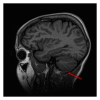Concurrent intracranial and spinal subdural hematoma in a teenage athlete: a case report of this rare entity
- PMID: 25349764
- PMCID: PMC4198776
- DOI: 10.1155/2014/143408
Concurrent intracranial and spinal subdural hematoma in a teenage athlete: a case report of this rare entity
Abstract
A 15-year-old male high school football player presented with episodes of headache and complete body stiffness, especially in the arms, lower back, and thighs, immediately following a football game. This was accompanied by severe nausea and vomiting for several days. Viral meningitis was suspected by the primary clinician, and treatment with corticosteroids was initiated. Over the next several weeks, there was gradual symptom improvement and the patient returned to his baseline clinical status. The patient experienced a severe recurrence of the previous myriad of symptoms following a subsequent football game, without an obvious isolated traumatic episode. In addition, he experienced a new left sided headache, fatigue, and difficulty ambulating. He was admitted and an extensive workup was performed. CT and MRI of the head revealed concurrent intracranial and spinal subdural hematomas (SDH). Clinical workup did not reveal any evidence of coagulopathy or predisposing vascular lesions. Spinal SDH is an uncommon condition whose concurrence with intracranial SDH is an even greater clinical rarity. We suggest that our case represents an acute on chronic intracranial SDH with rebleeding, membrane rupture, and symptomatic redistribution of hematoma to the spinal subdural space.
Figures



Similar articles
-
Concomitant Intracranial Chronic Subdural Hematoma and Spinal Subdural Hematoma: A Case Report and Literature Review.World Neurosurg. 2016 Jun;90:706.e1-706.e9. doi: 10.1016/j.wneu.2016.03.020. Epub 2016 Mar 18. World Neurosurg. 2016. PMID: 26996734 Review.
-
Migration of an Intracranial Subdural Hematoma to the Spinal Subdural Space: A Case Report.Korean J Spine. 2015 Sep;12(3):207-9. doi: 10.14245/kjs.2015.12.3.207. Epub 2015 Sep 30. Korean J Spine. 2015. PMID: 26512286 Free PMC article.
-
Spontaneous spinal subdural hematoma concurrent with cranial subdural hematoma.J Korean Neurosurg Soc. 2013 Jul;54(1):68-70. doi: 10.3340/jkns.2013.54.1.68. Epub 2013 Jul 31. J Korean Neurosurg Soc. 2013. PMID: 24044087 Free PMC article.
-
Traumatic Subacute Spinal Subdural Hematoma Concomitant with Symptomatic Cranial Subdural Hematoma: Possible Mechanism.World Neurosurg. 2019 Mar;123:343-347. doi: 10.1016/j.wneu.2018.12.053. Epub 2018 Dec 24. World Neurosurg. 2019. PMID: 30590215
-
Delayed Development of Spinal Subdural Hematoma Following Cranial Trauma: A Case Report and Review of the Literature.World Neurosurg. 2020 Sep;141:44-51. doi: 10.1016/j.wneu.2020.05.158. Epub 2020 May 22. World Neurosurg. 2020. PMID: 32450315 Review.
Cited by
-
Spinal subdural hematoma post foramen magnum decompression-rare complication in a patient with rhomboencephalosynapsis.J Spine Surg. 2017 Dec;3(4):719-722. doi: 10.21037/jss.2017.11.02. J Spine Surg. 2017. PMID: 29354754 Free PMC article.
-
Abusive head trauma: neuroimaging mimics and diagnostic complexities.Pediatr Radiol. 2021 May;51(6):947-965. doi: 10.1007/s00247-020-04940-6. Epub 2021 May 17. Pediatr Radiol. 2021. PMID: 33999237 Review.
-
An unusual cause of back pain in a child: spinal subdural haematoma secondary to intracranial arachnoid cyst haemorrhage.Quant Imaging Med Surg. 2016 Aug;6(4):478-481. doi: 10.21037/qims.2016.08.02. Quant Imaging Med Surg. 2016. PMID: 27709088 Free PMC article. No abstract available.
References
-
- Kreppel D, Antoniadis G, Seeling W. Spinal hematoma: a literature survey with meta-analysis of 613 patients. Neurosurgical Review. 2003;26(1):1–49. - PubMed
-
- Kokubo R, Kim K, Mishina M, et al. Prospective assessment of concomitant lumbar and chronic subdural hematoma: is migration from the intracranial space involved in their manifestation? Journal of Neurosurgery: Spine. 2014;20(2):157–163. - PubMed
-
- Khosla VK, Kak VK, Mathuriya SN. Chronic spinal subdural hematomas: report of two cases. Journal of Neurosurgery. 1985;63(4):636–639. - PubMed
-
- Cronberg S, Wallmark E, Soderberg I. Effect on platelet aggregation of oral administration of 10 non-steroidal analgesics to humans. Scandinavian Journal of Haematology. 1984;33(2):155–159. - PubMed
LinkOut - more resources
Full Text Sources
Other Literature Sources

